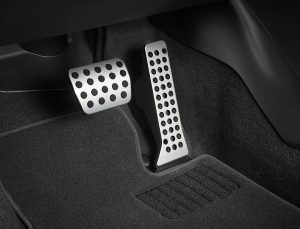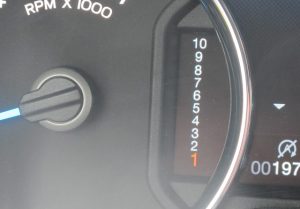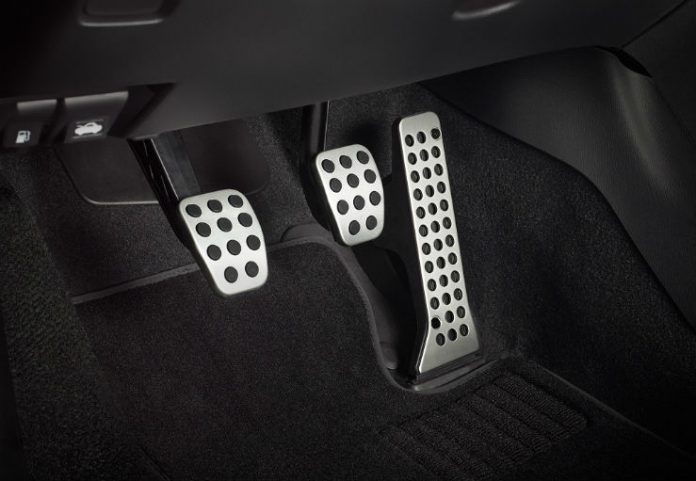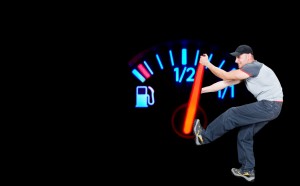Finding a manual transmission in a new car – even a new economy car – is becoming as hard as finding a curbside parking spot in New York City.
There are at least two reasons for this – one of them unnatural, the other a natural evolution of the unnatural.
The unnatural reason is government, a force – literally – which forcibly alters the course of what would otherwise naturally occur. It – to be precise, the people who are “the government” – has been using force to countermand the market (a natural force) for decades by, among other things, requiring all cars and trucks to use less gas, no matter what it costs us.
One such cost is the now-almost-universal automatic transmission – which has added to the cost of what used to be optional in almost all new cars – especially economy cars and pick-up trucks, most of which which used to come standard with manuals.
But why?
Automatics – today’s automatics – are computer-controlled transmissions that can be programmed to shift in such a manner as to deliver the highest possible MPG numbers on government fuel economy tests.
Manuals are human-controlled and so more variable.
But there’s a catch.
A con, actually. As is invariably the case when it comes to government – which is a force both malicious and incompetent at the same time.
The automated-equipped modern car touts such-and-such city/highway mileage – and it did achieve those numbers on government tests. But in real-world driving, the actual mileage is often less. While the manual-equipped car’s is sometimes more – assuming you can find one so equipped.
Here’s why:
The automatic’s programming is “to the test” – which has an effect on how the car drives. These two variables invariable come into conflict.
The transmission will seek the highest possible gear as soon as its programming (based on input from sensors) tells it an upshift is possible.
Most modern automatics have multiple overdrive gears – some as many as three of them (manuals generally have one overdrive gear). The idea here – if the goal is to score best on the test – is to get the transmission into the highest overdrive gear soonest, in order to reduce engine RPMs – which will generally increase MPGs.
The programmed urge to upshift often produces a sluggish feel. Which prompts the driver to push down harder on the accelerator to restore the right feel.
Unless the driver drives as if there were an egg under the pedal, any significant demand for acceleration will result in a downshift; sometimes several – which is necessary to restore the proper leverage relationship and cause the vehicle to move rather than just cruise.
Now the RPMs are up – and the mileage goes down.
So, it’s basically a trick. Very much of a piece with the mileage-touting of small – but turbocharged – engines as opposed to the mileage delivered by the larger (but not turbocharged) engines they replaced.
It is absolutely true that the smaller engines get better mileage . .. provided you don’t use the turbo (boost) much. But that means driving without much accelerating. If you accelerate in a manner as to replicate the acceleration the larger/no-turbo’d engine would have provided, you end up with the same and sometimes worse mileage, because the smaller engine ends up having to work harder to replicate the acceleration/performance of the larger engine which it replaced in the name of “efficiency.”
So you’re not really saving gas.
And you’re paying higher cost – for the turbocharger and its peripherals (e.g., the intercooler and specialized exhaust plumbing, higher-capacity cooling system and so on) that generally come with the turbo. There is also the potential down-the-road cost of replacing some or all of these parts.
As is also true with regard to the modern automatic. Whatever its touted gas-savings, these are reduced by the cost of the automatic itself, which is a more expensive transmission than a manual transmission because it’s a more complex device. Especially the modern automatic with its multiple overdrive gears and elaborate electronic controls. If it breaks and has to be replaced the cost can be more than the fix is worth relative to the value of the car.
Manuals rarely fail – and modern manuals often go 150,000 miles or longer on their original clutch. This is a wear item that will eventually have to be replaced but the cost is usually less than $1,000 vs. several times that to replace an entire (automatic) transmission.
Meanwhile, the manual-equipped car may give better mileage in real-world driving – even if not on the window sticker – depending on the human driver. If the driver is good at his job – knows when to shift up and down – he can outperform the programming of a computer, which controls the shift action based on fixed and so limited parameters.
It’s analogous to ABS/traction control reducing control/traction in certain conditions – because its programming isn’t as smart as a driver who knows how to.
But automatics are now the dominant transmission in new vehicles, even trucks – where manuals used to be the mainstay. This has been the case for going on 20 years now, with the tendency increasing with each uptick in the federal fuel economy fatwas.
Which brings us full circle to the natural consequence of the unnatural.
An entire generation that has grown up in an automatic-only or automatic-mostly world. They never learned to drive a manual-equipped car and so they don’t buy them. Which has created an artificial and synergistic “incentive” for the car manufacturers to manufacture fewer manual-equipped cars.
Thus, the automatic – with eight, nine and even ten speeds – is now the de facto standard transmission in more than 90 percent of all new vehicles.
As is the cost, in dollars as well as fun. Even if an automatic did deliver the mostest MPGs, even if they shift perfectly, every time – you’ve still lost something that maybe can’t be quantified in city/highway terms, but which is priceless.
Not necessarily the third pedal. The option to decide whether you want it rather than some freaky control freaks, i.e., “the government.”
They can’t stand the idea of us being able to choose whether to buy a car that gets 15 MPG or one that gets 30 MPG – on paper or in the real world.
In other words, they can’t stand the idea of the market taking precedence over their bullying.
Maybe someday, we’ll tire of this.
. . .
Got a question about cars, Libertarian politics – or anything else? Click on the “ask Eric” link and send ’em in!
If you like what you’ve found here please consider supporting EPautos.
We depend on you to keep the wheels turning!
Our donate button is here.
If you prefer not to use PayPal, our mailing address is:
EPautos
721 Hummingbird Lane SE
Copper Hill, VA 24079
PS: Get an EPautos magnet or sticker or coaster in return for a $20 or more one-time donation or a $10 or more monthly recurring donation. (Please be sure to tell us you want a magnet or sticker or coaster – and also, provide an address, so we know where to mail the thing!)
If you’d like an ear tag – custom made! – just ask and it will be delivered.
My latest eBook is also available for your favorite price – free! Click here. If that fails, email me at EPeters952@yahoo.com and I will send you a copy directly!












Had an 88 Toy 4runner that I bought brand spankin’ new. Manual Trans, and replaced the original clutch at 196,000 miles. It was totaled in 02 by a drunk driver, the week the odometer hit 300,000 miles. Replaced that 4runner with a 93 Toy pickup, also manual trans. I’ll keep that truck till I die or until the wheels fall off (then I’ll put em back on). I told my wife that if I go first, to bury me in the truck. She replied “I thought you wanted to be cremated ?” I replied, “I do, just put me in the ashtray”….
Another problem is the marketing. Unless you’re looking at a car like a Mustang or Corvette or something along those the lines the MT is usually only offered in the bottom of the line cheapskate package or the top of the line sport package and not both. So if you want an MT you may have to live without power windows and with the base engine and an interior your boss at work will opt for to keep his budget low but he never has to sit in. And if it’s not that, well you better open your wallet because you’ll need to have the top of the line sport set up with the most expensive engine and trim options.
Then dealers don’t stock MT vehicles as a rule so you have factory order it.
And they say manual transmission vehicles don’t sell.
I wonder why.
Bought a 2016 Jeep SUV as my business vehicle after my Tracker shook itself apart. Demanded a manual, because every car since I bought my first in 1973 has been a manual. It came with a turbo anyway.
At three years and 16k miles, the clutch started slipping and finally disconnected entirely. The dealer wanted $3,800 to fix it, and my local independent couldn’t cut more than a couple hundred off that.
Standard transmissions are no longer a deal.
Sounds like a Jeep thing to me. I’ll stick with Japanese or Korean cars, thanks! Maybe German, if it’s old enough.
Hi Tim,
I have a garage full of Japanese bikes for just this reason. I love the look of British bikes and have nothing against any bike. But the Japanese build bikes that almost never ask for anything except that you ride them. And when you do, they work!
I have two bikes myself, one a 91 Honda Hawk GT (if you’ve never had one, you have to try it!) and the other a 85 BMW R80RT. Both have been incredibly reliable and easy to work on! The BMW has 268k miles and runs like a top, a testament to the regular maintenance and smart upgrades my dad performed. I’ll keep riding her as long as I can, keeping his memory alive!
Hi Tim,
I’ve ridden the Hawk! It’s a great bike; just a little small for a big geek like me!
I find it comfortable enough, and I’m 6’4”! My dad was always mystified by my love of small bikes/cars. Speaking of which, I just picked up a 2011 Honda Fit (base 5 speed) and I’m loving it so far. I looked for your review but it looks like you skipped the 2nd gen. It’s definitely got plenty of headroom for me.
The answer, as given by the manufacturers, is the “manual mode,” often with shifting paddles on the steering column. These came from the racing world where the point of the automobile is to win races, not enjoy the ride. They offer a shift that is “better than human” because of the dual-clutch design. One clutch for odd gears, another for even. They can shift in less than a half-second because there’s a common shaft that moves inches per shift, as long as you don’t skip gears. Of course skipping is technically not possible because the flappy-paddles are labeled + and -, not with a gate pattern. And if you do shift even-to-even or odd-to-odd it takes much longer to shift because it can’t preselect the next gear.
But in practice the illusion of control falls apart. The drive can bump the shifter down (such as when wanting to scrub off speed into a downhill turn), but the transmission won’t shift until it determines the speed and engine all fit the programming, which won’t happen until you get on the brake or rev the engine to the redline. Either way it’s no better than an automatic with a kick-down switch on the gas pedal and completely worthless for engine braking.
There are ‘full manual valve bodies’ available for many of the older automatic transmissions. I have also seen people use toggle switches (and other things) to control the shift solenoids on electronic automatics for use without a controller/pcm.
AFAIK if it is an electronic trans it will run at full line pressure all the time and I am not certain if they use the over run clutches (for engine braking) in every gear.
Depending on the usage, still not as good as a manual trans (except at the dragstrip).
Also: I am told that on the 1-2 shift the planetaries must change direction (of rotation) so a quick/firm/sometimes chirp tires 1-2 shift seems to be better for transmission life than a harsh/guranteed tire chirping 1-2 shift.
Looser (stall speed) converters can mitigate a harsh shift but will not engine brake as well.
This is one thing I never got – Americans know and respect their cars, and its a driving country like few others. Why then are manual transmission cars so rare (even before government got involved with all their red tape forcing more autos, as even as a kid autos were much fewer)!! Fine I understand when someone reaches a certain age it is tempting to lay back and just drive with one foot, but the joy of a manual takes driving to another level….
Hi Nasir,
They are rare now. They were common before the ’90s. I realize that’s 30 years ago in the rearview… but the point stands. For most of automotive history manuals were standard in most cars and common generally.
They aren’t anymore for the reason laid out in the article.
Nasir, my fil used to drive small cars with manual trannys and no power steering. He was quite tall and I see he had troubles operating the clutch due to his height. I advised him to get another car with an auto and PS and move up to a mid size car. He got an 84 Camry with those additions and really began to enjoy driving. He was in his mid 60s at this time. I’ve driven both types of trannies. With the increasing congestion of traffic here in Melbourne, driving a manual is no fun and becomes downright painful after a while. I prefer the auto because I need to concentrate on what is happening all around me without worrying about shifting a transmission every time I change speed or have to hit the brake pedal hard. That is why there is no rebellion against the disappearing manual tranny.
Like all “automatic” devices, the AT cannot evaluate conditions in advance. It does not see the hill you are about to ascend or descend, and shift accordingly. Which is why cruise control is virtually useless on hilly twisty two lane blacktop. Having lived where the only way out is on such black top for 30 years, ATs are equally inept. For the two AT equipped cars I have owned for the period, I was easily able to IMPROVE gas mileage by manually shifting the AT. Lower RPM is not the end all be all of gas mileage, unless you drive in central Kansas all the time, or on an EPA test track.
yep
most A/T vehicles I have driven with lockup converters will unlock if you (completely) lift off the gas and and then get back on the throttle. I used to get an extra bit of mpg out of my regal gs on the highway by unlocking the converter just before the larger hills and such.
Lugging the motor is not a good thing on boosted gas engines and can hurt mpg depending on how the vehicle is tuned. The regal would build boost before unlocking the converter if you ran the cruise control and mpg would suffer for it. The extra ~300 rpm with the converter unlocked allowed less throttle input.
I saw about a 1.5 mpg difference – your mileage may vary.
Maybe it’s just me because I learned on a clutch, but those who can drive a manual have a better feel and command of the auto and the road. And not to mention that those drivers display more safeeeety habits while on the road while not being a pesky clover.
H Allen,
Understanding how to drive a stick-shift car is like understanding how to use a gun or frame a wall or clear a clogged sink. These are all species of competence, which builds confidence. Incompetence breeds dependence – which explains why so many people look to government to “help” them.
Absolutely! It simply requires the driver to be more involved in what they are doing. Damned hard to text while driving around town with a MT.
Manual transmissions also make great anti-theft devices cause car thieves can’t drive them away!
There’s another huge difficulty with keeping the manual around, and that’s NOx and hydrocarbon emissions. The reason is that when you press the clutch, the engine very briefly goes “off script” as you remove the load, and makes a little puff of extra emissions because it wasn’t expecting the clutch to disengage. With an automatic transmission, the two work together, so just as the transmission shifts, the ECU adjusts fuel so you don’t get this puff. Some manual cars have a little sensor on the clutch to try to get a leg up on this, but the only way to really do it is with very tricky adaptive tuning, or to have a electronic clutch pedal, where the computer can orchestrate the mechanical clutch and engine behavior together.
This problem is not insurmountable, but it’s expensive, and you have to recoup the costs on the few manual units that you do sell.
Modern cars are so clean, that these emissions due to shifting are really insignificant, but as the regulations crack down, the manufacturers have to address every single source. A modern car (2000+) is so clean, that if it ingests smog on a smoggy day, the emissions are cleaner than what it took in.
Here in CA, most of our emissions are now caused by older cars and trucks. Passenger cars no longer contribute in a meaningful way, but yet, the regulatory ratchet continues to tighten down.
Still have my Audi for a weekend toy, love driving it even if the exhaust drones, thought rather than finish it (turbo), going to instead save for a 90s car to be my project car
Truck isn’t bad, but the automatic leeches from the experience, hopefully the software tuning when install the shorties and y-pipe make it more aggressive, as it’s hardly efficient to begin with.
Save the manuals, by the classics
I drove a stick for several years (2006 Mustang). My newest car, 2016 Mustang, is automatic, both 6 cyl. I have definitely noticed the sluggish transmission. I feel like I’m running the poor car to death by constantly stomping on the gas pedal to get it to move. While my stickshift accelerated smoothly and quickly no matter what speed I was going – provided I put it in the right gear – the 2016 has certain speeds it just doesn’t “like.” If I try to punch it from, say, 40 mph, I can feel a hesitation, like it’s getting gas but just not moving, then all of a sudden it will rocket forward with a meek little “vroom” sound. It’s really frustrating and has kind of turned me off Mustangs I’m sorry to say.
I’ve noticed this “acceleration lag” with Chevys, but never with my Mustangs. I’ve had 7 or 8 of them over my life, both manual and auto, small and big engines, ranging from brand new to shouldn’t be on the road at all. I’ve always been happy with the car.
A manual is way more fun if you actually enjoy driving. Impresses the girls too. Automatics are a bit gay. Also the best antitheft device around because kids today cant drive them.
Hi Mark,
I agree completely. My TA’s auto has been set up to shift hard (chirps tires on the 1-2 and the 2-3) but it’s just not as much fun as my old TA’s Super T-10!
I don’t agree. I have owned cars with automatic transmissions and it is obvious to me that today most people just cannot shift gears as economically as the computer programmed transmissions can. Also almost all of my friends just can’t shift gears optimally, since they often drive in 3. or 4. gear on the highway, when 5. or top gear is mandatory. One of my friends even says: “Why do I always get the cars that use far too much fuel”. (It is because he always keeps the engine at about 1000 rpm more that necessary).
In addition a miracle also happened at the VAG factories about 15 years ago, when the automated direct shifting gearbox was invented. These automated gearboxes took the whole thing of economic automatic transmissions to a new level.
I have yet to see an automatic that knows to hold a lower gear (or even unlock the converter) because there is a big hill ahead. Or to engine brake rather than coast when lifting off throttle.
Driver skill is not the fault of the transmission and idiots can just as easily destroy either type of trans.
Eh well, when going up-hill, the automatic will switch down when necessary. I had a car with an automatic transmission for 10 years, and it never once happened that I choked the engine when going up-hill. It shifted down when the engine didn’t pull anymore. However, with a diesel engine you would be surprised how steep hills it would go up while still in the top-gear, or only shifting down from the 6. to 5.
Going downhill is a different story. The automatic may not shift down, which was not a problem for me, because I always used the brakes to limit the speed.
You know Jone, you can downshift an automatic to a lower gear selection when going downhill. It is far better to downshift and let the compression of the engine provide some braking, using your brakes that exclusively will overheat them leading to brake fade and premature brake wear. A transmission can handle it provided you don’t down shift more them one gear at a time and watch your speed. I have a 2000 Chevy C3500 pickup with an automatic and I pull two trailers behind it, my camping trailer and a utility trailer with a 4 wheeler or a 5X8 cargo trailer depending what I am needing it for and I drive all over the Rockies and other mountainous areas. Now, I am a retired truck driver and I know how to use my gears and 5mph braking down steep inclines.
If you are pulling a heavy trailer, that changes things. Then I suppose that it is a “must” to use the engine to brake when going downhill.
With a passenger car there is nothing wrong in using the motor-brake when going down-hill. Yet, my experience as a very skilled driver is that there is usually nothing wrong in using the brakes either (depends on the hill). I have used both, yet one of my previous cars had weak brakes that faded easily, which made it more mandatory to use the motor-brake.
Hi Jone,
I never said “most people.” I said people who know how to drive. And not learning how to drive stick almost always means a person who never really learned how to drive.
“most people” are idiots
Eric,
You wrote, “The automatic’s programming is “to the test” – which has an effect on how the car drives.”
How is this different than what Volkswagen did with the emissions test? The programmed the computer to perform well on the test but, in real world driving it performed differently…and still didn’t pollute if the various tailpipe measurements done via random off ramp locations and/or annual sniff tests are to be believed accurate.
I guess all cons are equal but some are more unequal than others.
Very solid pont, Mark – in re the “cheating.”
But it all comes down to whether Authority is affronted, or an agenda not served.
I guess it’s just another computer variable to modify if you want to drive your car instead of letting it handle everything.
I’ve got one of each now, a CVT and a 5 speed stick. Time will tell, as they are both new to me within the last month, but I’ll bet I can get far better mileage out of the stick than my wife does with her CVT! Of course, my engine is a 1.5 vs her 2.5, but I’ll compare what we each get to the EPA ratings for our cars.
The Volkswagen was set up to run in reduced-emissions mode only when tested, and performed normally on the road. The top-gear-rushing (and easily discombobulated) automatics continue to operate as tested in everyday use.
Same with the laggy throttle response in some DBW cars. That, too, is a way to sneak around the highly-regimented testing routines, but is allowed because the car continues to operate that way, reducing functionality, annoying the driver, and even creating dangerous situations, out in the wild.